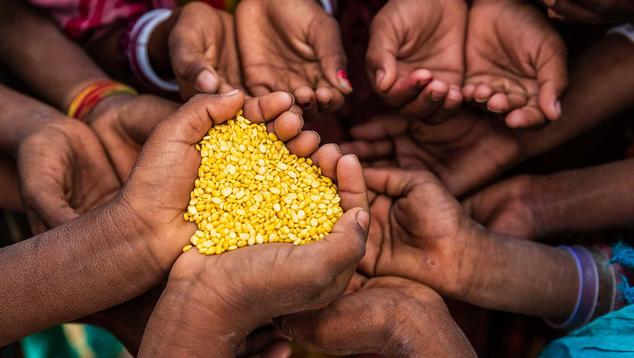Although hunger at the global level stopped rising in 2022, the latest State of Food Security and Nutrition in the World (SOFI) report shows that it is still increasing in many places around the world and that levels of both hunger and food insecurity remain higher today than they were before the pandemic.
The report released in July draws on data from many sources -- including food security data collected for the Food and Agriculture Organization of the United Nations (FAO) via the Gallup World Poll* -- to provide the latest update on the world’s progress toward ending hunger and ensuring food security.
This update shows that while hunger is no longer on the rise at the global level, the world is still far off track to reaching its sustainable development goal (SDG) of achieving “zero hunger” by 2030.
In addition to examining these global trends, the report focuses on a megatrend that needs to be fully understood to get the world back on track -- urbanization. For the first time, the report examines differences in food insecurity through the lens of rural, peri-urban and urban populations and looks at how food supply, cost and demand intersect across the urban-rural continuum.
Key Findings
Global hunger stopped rising in 2022 but remains above pre-pandemic levels.
The prevalence of undernourishment** -- the FAO’s traditional indicator of the extent of hunger -- was 9.2% in 2022, virtually unchanged from 2021. Hunger affected between 691 million and 783 million people last year, which is 122 million more than in 2019, before the pandemic.
Further, on the current trajectory, almost 600 million people are projected to still be chronically undernourished in 2030 -- about 119 million more than if neither the pandemic nor the war in Ukraine had occurred and 23 million more than if the war had not happened.
The relative lack of change in hunger between 2021 and 2022 at the global level hides important differences. In Asia and Latin America, there has been some progress in reducing hunger. However, hunger is still on the rise in Western Asia, the Caribbean and all regions of Africa, where the proportion of the population facing hunger -- 20% -- is much larger compared with the rest of the world.
At the global level, there was no progress toward reducing food insecurity, which remains much higher than it was before the pandemic.
For the second consecutive year, the global prevalence of moderate or severe food insecurity -- which the FAO inform annually using the Food Insecurity Experience Scale (FIES) data, collected in large national surveys, the Gallup World Poll and other sources -- remained unchanged, but far above pre-pandemic levels.
In 2022, an estimated 29.6% of the world’s population -- 2.4 billion people -- were moderately or severely food insecure, which means they did not have access to adequate food. This is approximately 391 million more people than in 2019, before the pandemic, and 745 million more than in 2015, when the U.N. launched the 2030 SDG agenda.
Moderate or severe food insecurity rose slightly in Africa and in Northern America and Europe. Latin America and the Caribbean was the only region that showed signs of progress, but this was primarily confined to South America. In Latin America and the Caribbean, moderate or severe food insecurity decreased from 40.3% in 2021 to 37.5% in 2022, or about 16.5 million fewer people.
Food insecurity continues to affect more women than men. The gender gap in food insecurity narrowed from 3.8 percentage points in 2021 to 2.4 points in 2022, suggesting that the effects of the pandemic that disproportionately affected women have eased globally and in some regions.
The gender gap diminished notably in Asia and in Latin America and the Caribbean but widened in Africa and in Northern America and Europe.
At the global level, food security improves as the degree of urbanization increases.
As urbanization increases, rural and urban areas are becoming more entangled, and examining food insecurity through the lens of a simple urban-rural divide is no longer enough.
The availability of georeferenced FIES data on food insecurity in 2022 made it possible for researchers to compare -- for the first time -- levels in rural, peri-urban and urban areas using the Degree of Urbanization (DEGURBA) classification, a new international standard.
The classification was used to distinguish among populations living in rural areas, towns and semi-dense areas (peri-urban areas), and cities (urban areas) based on population density and size, in a globally comparable way.
The results showed that at the global level, food security improves as the degree of urbanization increases. Moderate or severe food insecurity affected 33.3% of adults living in rural areas in 2022, compared with 28.8% in peri-urban areas and 26.0% in urban areas.
Food insecurity, at both levels of severity, is higher in rural areas than in urban areas in all regions of the world except Northern America and Europe. In this region, food insecurity is worse in urban areas than in rural areas.
These regional differences can be at least partly explained by filtering them through a country-income group lens. For example, in low-income economies, rural and peri-urban populations are more food insecure than urban populations, while in lower-middle-income economies, food insecurity is highest in rural areas but only slightly worse in peri-urban than urban areas. In high-income economies, the urban population is at higher risk of moderate or severe food insecurity.
Implications
The latest SOFI report shows the prospects for ending hunger were not any worse in 2022, but they were also not any better. However, the fact that hunger did not increase may provide hope that the situation could turn around.
Looking at hunger and food insecurity through the new lens of urbanization may help in those efforts and provide a better understanding of the growing links across urban, peri-urban and rural areas that can inform policies and investments to get the world back on track.
To stay up to date with the latest Gallup News insights and updates, follow us on Twitter.
* The data for the FAO's Food Insecurity Experience Scale (FIES) are collected directly from respondents to surveys, including the Gallup World Poll and other sources.
** The FAO uses different data sources to estimate the different parameters of the model for the prevalence of undernourishment. Prevalence of undernourishment are nowcasts based on data on food availability and access to food at the country level.
Julie Ray, Sara Viviani and Anne Kepple contributed to this article.
Sara Viviani is a statistician of the FAO's Food Security and Nutrition Statistics team.
Julie Ray is a writer and editor at Gallup.
Anne Kepple is a food security expert of the FAO's Food Security and Nutrition Statistics team.




